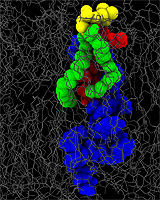New Role for Membrane Components
9 January 2012

Source: Erik Lindahl, Royal Institute of Technology & Stockholm University
With the help of a newly devised procedure, Heidelberg University biochemists have cast light on the hitherto largely unexplained functioning of membrane components. In conjunction with bioinformaticians at Stockholm University, scientists at Heidelberg University Biochemistry Center (BZH) have discovered in cell membranes a highly specific recognition and interaction between the hydrophobic part of a protein and a lipid. This interaction regulates an intracellular transport process. Previously, biochemists had regarded interaction at this level of specificity within a lipid phase to be improbable. The research findings have been published in the journal „Nature“.
“The reason why this new and unexpected role played by a membrane lipid component is exciting is that biological membranes are made up of over 1,000 different lipid components that bind precisely with some of the over 10,000 membrane proteins and thus regulate their activity,” says Prof. Dr. Felix Wieland of BZH, who heads the research group together with Dr. Britta Brügger. “These findings open the door for investigation of a novel molecular control mechanism for cellular activities.” In their investigations, the Heidelberg scientists cooperated with research groups at Stockholm University headed by Prof Dr. Gunnar von Heijne and Prof. Dr. Erik Lindahl.
To understand how the transport of membrane vesicles in a cell actually works, the scientists devised methods by which all the lipid components in a biological membrane can be identified with high sensitivity and quantitative accuracy. “When we took a closer look at these vesicles, we noticed that their lipid composition was different from that of the membranes from which they had formed,” says Dr. Brügger. “The only explanation for this difference was the assumption that there is a highly specific recognition between components in the membrane.” Accordingly, the scientists developed a method for measuring such lipid-phase interactions in the test tube. This enabled them to confirm findings from the living cell and to characterise a structural feature of the relevant protein that is responsible for the specificity of the interaction. “If you ‘transplant’ this structural part to a different protein formerly unable to recognise the lipid component, the protein acquires the ability to bind that specific component,” says Prof. Wieland.
The scientists also identified a function of this precise interaction. Via binding the lipid stimulates its protein to join up with an identical protein. Only the resulting “double protein” can contribute to the formation of a transport vesicle. “So the lipid component assumes the role of a ‘co-factor’ and thus regulates a cellular process,” says Prof. Wieland. So far, the scientists in Heidelberg and Stockholm have identified about 50 membrane protein candidates that could undergo similarly specific interactions with the various members of just one family of membrane components.
For more information go to www.uni-heidelberg.de/zentral/bzh
Note for newsdesks
Picture material is available from the Press Office.
Original publication
F.-X. Contreras, A.M. Ernst, P. Haberkant, P. Björkholm, E. Lindahl, B. Gönen, C. Tischer, A. Elofsson, G. von Heijne, C. Thiele, R. Pepperkok, F. Wieland, B. Brügger: Molecular recognition of a single sphingolipid species by a protein’s transmembrane domain. Nature (8 January 2012), doi: 10.1038/nature10742
Contact
PD Dr. Britta Brügger and Prof. Dr. Felix Wieland
Heidelberg University Centre for Biochemistry
phone: +49 6221 545426 or 544150
felix.wieland@bzh.uni-heidelberg.de
britta.bruegger@bzh.uni-heidelberg.de
Communications and Marketing
Press Office
phone: +49 6221 542311
presse@rektorat.uni-heidelberg.de

